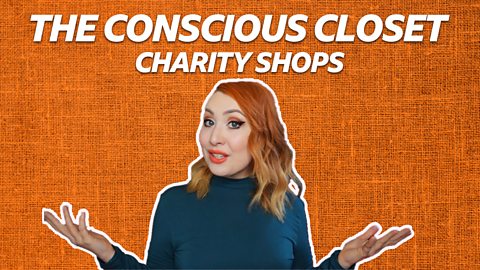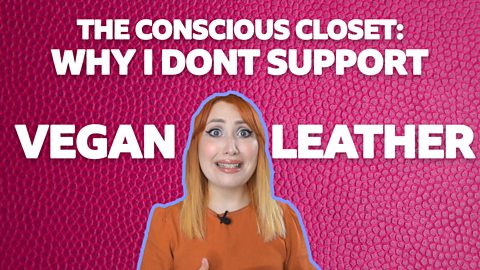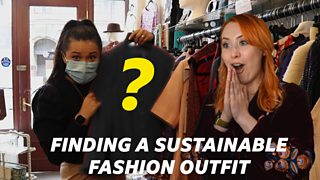Why we should reduce, re-wear, and repair - the real impact of your wardrobe on the environment
By Alice Cruickshank // ����ý The Social contributor // 24 April 2022
None of us want the clothes we buy to harm people or the planet, but the alternative of shopping with ethical and sustainable brands can just feel so unaffordable. Most of us - myself included - don’t have that level of disposable income.
But that doesn’t mean we can’t be critical of the fashion system, and demand more of the brands that we give our hard-earned cash to. The reality is: the fashion industry is exploitative, environmentally damaging, and ultimately providing us with poor quality clothing that isn’t good value for money (despite the low price tag). Worst of all? The industry is grossly exaggerating its efforts to counter these harmful practices.
I want to take fashion’s dirty secrets out of the closet so that we can all make good choices, whilst keeping the onus firmly on the fashion industry to make access to affordable, quality clothing better for everyone.
The true cost of fashion

Why is Fast Fashion So Cheap?
Are we asking the right questions about ethical fashion? Alice breaks it down.
It’s true that some ethical brands are expensive, but there’s also a lot of myths around how much clothes should actually cost. I think instead of asking: ‘why is ethical fashion so expensive?’, we should be asking: ‘why is fast fashion so cheap?’.
High Street brands want us to believe that economies of scale is the ONLY reason their clothes are so cheap. That’s just not true.
Mainstream fashion is involved in what’s known as a race to the bottom. Since the 1980s fashion brands have moved from country to country to find the lowest paid garment workers in an effort to maximise their profits.
They then push these factories to produce these garments with a mega fast turnaround, and for as little cost-per-item as possible. And it’s garment workers who feel the pinch here, as they are often forced to work unpaid overtime, sometimes working for as long as 18 hours per day.
Call me a dreamer, but I would love to live in a world where the term ‘ethical fashion’ no longer exists, as all fashion brands pay their workers fairly.
Call me a dreamer, but I would love to live in a world where the term ‘ethical fashion’ no longer exists, as all fashion brands pay their workers fairly. It shouldn’t have to be affordable clothing for us, or better conditions for workers. Big brands are capable of achieving that middle ground if they choose to prioritise it.
Demand more of the big fashion companies. Tweet them, email them, sign petitions, and support charities that work for garment workers’ rights.
The fashion industry needs to change, and you don’t need to spend anything to share your opinions on that.
Greenwashing

Greenwashing | The Conscious Closet
Often your favourite fashion brands aren't as ethical as they seem, as Alice explains
These days it feels like you can’t move for big fashion companies releasing a sustainable, conscious, or eco collection. Sounds like the fashion industry is improving for the better, right?
Unfortunately, as much as I would love that to be true, no. Sorry. Fashion is greenwashing you.
Greenwashing is when brands exaggerate or plain make up claims of their sustainability credentials, which misleads us as consumers into thinking that we are making a conscious choice. That’s because going green is big business, as fashion lovers become increasingly aware of their environmental impact.
The trouble with greenwashing is that we as consumers are being duped into thinking we are making a conscious choice, when actually what we’re buying is still having a huge environmental impact, not to mention the continued exploitation of the people who made our clothes.
The trouble with greenwashing is that we as consumers are being duped into thinking we are making a conscious choice.
Here’s my tips for spotting greenwashing -
Look at the language being used - If a brand is going hard pushing vague terms like ‘sustainable’, ‘green’, or ‘eco’ without any evidence of what this actually means, then chances are they are greenwashing you.
Examine the numbers - If only a tiny, capsule collection of a brand’s offering is made with ‘sustainable’ fabrics (and it is releasing thousands of new items a year), then that brand is not sustainable at all.
Realise that ‘sustainable’ doesn’t equal ‘ethical’ - Brands might be shouting from the rooftops about their low-key efforts at sustainability, but they are still leaving garment workers’ rights out of the conversation.
Ultimately, if a brand isn’t producing its clothing ethically, can we really call it sustainable?
Charity shopping

Charity Shops - What Really Happens To Your Clothes | The Conscious Closet
Thinking of a lockdown closet clear-out? Here’s what really happens to your old clothes.
A wardrobe clearout is super satisfying, and you’re probably tempted to give all the stuff you don’t want to a charity shop. After all, the more we donate, the more we’re helping good causes, right?
Hmmmmm, maybe not.
Let’s be clear: I’m not anti-charity shop, in fact I love them. And when most of us donate clothes to charity, it’s because we genuinely believe that our unwanted clothes will be helping people one way or another. But it’s really important that we realise the full journey of our discarded clothes, and how it affects both our planet, and the livelihoods of people all around the world.
You see, our charity shops are drowning in a sea of unwanted clothes all year round, and much of this ultimately ends up in landfills, or is pawned off to countries in the Global South.
Around 70% of the clothes donated globally end up in Africa. In Ghana these are known as ‘Dead White Man’s Clothes’.
Around 70% of the clothes donated globally end up in Africa. In Ghana these are known as ‘Dead White Man’s Clothes’. The reality is, no one has died in them: they’ve not had a chance to.
Secondhand sellers in Africa often struggle to make a profit from the bales filled with our poor quality fashion, and shoppers in those markets are left with our thin, bobbly, stained, ripped and otherwise unfit for purpose clothing. Ultimately, a lot of those clothes still end up in landfill anyway, just in a different country.
The harsh reality is, we don’t just need to be finding more conscious ways to say goodbye to our clothing - we need to be buying so much less, and buying so much better. That way when the time comes to donate our clothes, they will be much more suitable for someone else - either in the UK or abroad - to give them a second life.
And when you need something new? Try the secondhand first approach. The more we all shop in our local charity shops, the less clothing will ultimately end up as waste.
Vegan leather

Why I Don't Support Vegan Leather | The Conscious Closet
Alice explains her beef with vegan leather.
Leather is a loaded topic in sustainable fashion circles. That’s because both ‘real’ and ‘vegan’ options have their downsides.
Also known as ‘fake’ or ‘synthetic’ leather, or my favourite, ‘pleather’, vegan leather fabric is traditionally made from one of two types of plastic material - Polyurethane or Polyvinyl Chloride, a.k.a PU and PVC.
And that ‘poly’ part? It means plastic.
The obvious issue with plastic is it doesn’t biodegrade and it’s made from fossil fuels. And in my experience, plastic leather alternatives also don’t last very well. All those synthetic leather shoes we’ve owned for a year and then chucked? Probably still rotting in a landfill somewhere.
Is real or fake leather better? No one seems to have the definitive solution.
So if textiles made from plastic are bad, textiles made from animal hide are… good? Well no, not really. I told you it was complicated!
We need to be aware of toxic chemicals used in the preserving, or tanning, process. The main offender is Chromium, and while this is illegal in the EU, much of the leather used in the fashion industry comes from India or Bangladesh. Workers in these countries come into contact daily with highly toxic chemicals that cause medical issues such as asthma, rashes, skin conditions, and even lung cancer.
And tanning chemicals aren’t just hurting people, but the planet too, causing pollution to waterways. We also need to consider the environmental impact of the cattle reared to produce the leather in the first place.
I’ve been casually researching for a few years now about whether I should be buying real or fake leather for my own wardrobe, and to be honest no one seems to have the definitive solution.
That’s because, like everything, the answer is nuanced, and your personal preference is valid. If animal products are an absolute no-go for you then there are better alternatives. And if you prefer the longevity of real leather, we can make better choices here too.
Ultimately, whether you’re into vegan or real leather, shopping new or secondhand, or wearing high-end or High Street, ‘reduce, rewear, and repair’ is the mantra that we all need to live by.





